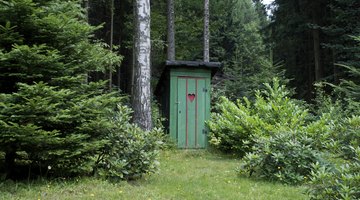How to Use Lime in an Outhouse
The modest outhouse offers waterless waste management that is environmentally friendly and simple to maintain, whether it serves as your privy at the cabin or as a cost-effective restroom on a far corner of your property.

Things You Will Need
- Bucket of calcium hydroxide
- Scoop
- Work gloves
- Face mask
- Safety goggles
Tip
Limit your outhouse to human waste and toilet paper -- avoid using it as a receptacle for items such as food refuse, diapers, wipes or gray water, as these may inhibit decomposition and increase odors. Although it effectively reduces odors, lime also slows decomposition, so use it as sparingly as possible. “Cabin Life” magazine recommends using wood ash as an alternative to encourage decomposition, though it does not curb smells as effectively as lime. Other lime alternatives include aromatic sawdust and straw or peat moss. Install a plastic or metal exhaust pipe at least 4 inches in diameter and a 1 1/2- to 2-inch air inlet pipe just under the outhouse bench to encourage proper ventilation. These pipes should run to roughly 2 feet above the roof and feature screens to keep insects from entering the structure.
Warning
If your skin comes in contact with lime during application, wash with soap and plenty of water immediately. If you get lime in your eyes, irrigate them immediately and thoroughly.
In both pitted and tank-equipped outhouses, bacteria, earthworms and insects promote natural waste decomposition, but the process is slow, leaving plenty of time for odors to linger. Enter lime, a time-tested method for reducing outhouse odors and warding off pesky flies.
-
Keep a covered, water-tight bucket of calcium hydroxide next to or inside the outhouse for easy access. Also known as hydrated lime, calcium hydrate, caustic lime or slaked lime, this product can be found at your local feed store.
-
Dip a scoop, which should have a capacity of about one cup, into the lime and pour the lime into the outhouse hole after each use. Sprinkle the lime slowly and gently to avoid producing dust clouds or getting the substance on your skin or in your eyes, which causes burns. Likewise, avoid getting lime on the outhouse's seat.
-
Repeat the process each time you put solid human waste into the outhouse or when odors become particularly strong. When applying more than a cup of lime to combat longstanding odors, wear work gloves, a face mask and safety goggles to protect yourself from clouds of lime dust.
References
Resources
Writer Bio
Dan Ketchum has been a professional writer since 2003, with work appearing online and offline in Word Riot, Bazooka Magazine, Anemone Sidecar, Trails and more. Dan's diverse professional background spans from costume design and screenwriting to mixology, manual labor and video game industry publicity.
Photo Credits
- kelifamily/iStock/Getty Images
- kelifamily/iStock/Getty Images
More Articles



